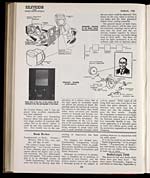John Logie Baird (1888-1946)
Baird colour television
TELEVISION
AND
SHORT- WAVE WORLD
MARCH, 1938
[NLS note: a graphic appears here – see image of page]
the Crystal Palace, and it was ap-
parent what excellent reproduction
had been obtained.
There are some very interesting
features about this apparatus and a
very large number of practical diffi-
culties had to be solved before it
could be put into successful opera-
tion. One trouble was in the con-
struction of a mirror drum that at
the high speed of revolution would
not distort the mirrors or burst. De-
pending upon the method of securing
the mirrors to the drum, they would
either bend outwards and become
convex or inwards and become con-
cave until a suitable method of con-
struction had been developed. The
fire regulations of the L.C.C. had
also to be overcome and this necessi-
tated the entire receiver and projector
being enclosed in metal cases with
only a small peephole through which
the arc crater could be observed. This
latter, by the way, takes a current of
150 amps. and the heat generated
makes water cooling essential.
The general layout of both trans-
mitter and receiver will be clear from
the schematic drawings and it will be
seen that the drum and disc are
directly coupled together by means
of reducing gearing, one motor being
used to drive both. The Kerr cell
used for light modulation is of the
ordinary type with an aperture about
3/16 in. square. Other types of cell
using both rays were tried, but it was
found that gains obtained in one
direction were more than lost in
others and that the ordinary type
gave the best results. Actually
the transmitter is mounted on a bogie
of much the same type as is used for
the Emitron camera and it is there-
fore reasonably flexible in use. The
entire apparatus is a beautiful piece
of work and reflects great credit on
the production engineers of the Baird
Company.
========================
Book Review
Fundamentals of Radio. Terman—
McGraw Hill & Co., 21S., 450
pp., 278 figs, in text.
The author's larger book “Radio
Engineering ” was recently reviewed
in these columns, and to those who
cannot afford the higher cost of the
full text-book, this new abbreviated
work will appeal. The author admits
that it is an abridged version of
“Radio Engineering,” but the treat-
ment has been so cleverly done that
nothing of importance has been
omitted.
The chapters are divided into:
Fundamental Components, Circuit
Elements, Vacuum Tubes as ampli-
fiers, power amplifiers and oscillators,
Modulation, Radio Transmitters and
Radio Receivers.
Although the treatment is elemen-
tary, a complete set of problems is
appended to each chapter, and the
serious student cannot fail to obtain
a thorough grasp of the subject in
working them out in conjunction with
the notes given.
It is not too much to say that either
“Radio Engineering,” or its younger
brother “Fundamentals of Radio,”
are vital books to the radio engineer
and no one can afford to be without
at least one of them.
____________
Radiolympia 1938
The dates for the next Radio Exhi-
bition have now been fixed. The
show opens Wednesday, August 24,
and closes on Saturday, September 3.
152


